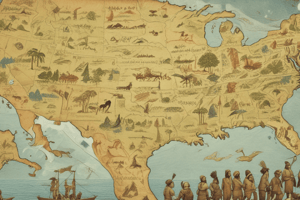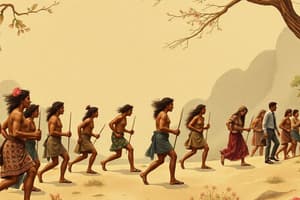Podcast
Questions and Answers
How long ago did the earliest human beings appear on Earth?
How long ago did the earliest human beings appear on Earth?
- 4.5 million years ago
- 1.5 million years ago
- 3.5 million years ago
- 2.5 million years ago (correct)
What did early modern humans adapt to in order to survive?
What did early modern humans adapt to in order to survive?
- The rise and fall of seafood prices
- The migration of wild animals
- Changing social structures
- The cycling of warm and cold periods in Earth's climate (correct)
What is the primary source of tools and artifacts found by archaeologists at sites inhabited by hunter-gatherers?
What is the primary source of tools and artifacts found by archaeologists at sites inhabited by hunter-gatherers?
- Wood
- Metal
- Bone
- Stone (correct)
How did hunter-gatherer groups obtain their food supply?
How did hunter-gatherer groups obtain their food supply?
What did hunter-gatherers use to clothe themselves?
What did hunter-gatherers use to clothe themselves?
What characterized the way of life of early modern humans who lived nearly 30,000 years ago?
What characterized the way of life of early modern humans who lived nearly 30,000 years ago?
What is the primary characteristic of a hunting-and-gathering economy?
What is the primary characteristic of a hunting-and-gathering economy?
What is the name given to the period in human history that began 2.5 million years ago and ended around 3000 B.C.E.?
What is the name given to the period in human history that began 2.5 million years ago and ended around 3000 B.C.E.?
What materials were commonly used by ancient hunter-gatherers to craft tools?
What materials were commonly used by ancient hunter-gatherers to craft tools?
What is a common feature of the shelters built by hunter-gatherers?
What is a common feature of the shelters built by hunter-gatherers?
What is the widely held theory about the origin of modern humans?
What is the widely held theory about the origin of modern humans?
What led to the emergence of permanent shelters in early human societies?
What led to the emergence of permanent shelters in early human societies?
What was a common characteristic among ancient peoples as they developed more sophisticated societies?
What was a common characteristic among ancient peoples as they developed more sophisticated societies?
What was the result of population becoming more concentrated in early human societies?
What was the result of population becoming more concentrated in early human societies?
What was the outcome of the development of agriculture in early human societies?
What was the outcome of the development of agriculture in early human societies?
Flashcards are hidden until you start studying
Study Notes
Human Migration and Development
- Around 60,000 years ago, humans migrated out of Africa, spreading to Asia, Australia, and Europe, replacing existing human populations.
- All modern humans originated in Africa, according to a widely held theory.
Early Human Survival
- Early modern humans survived by roaming the land in search of wild animals to hunt or collecting berries, nuts, and seeds to eat.
- Around 10,000 years ago, humans began settling down and turned to agriculture, raising crops and animals for food and clothing.
Impact of Agriculture
- Agriculture allowed humans to live in one place, leading to permanent shelters, population growth, and larger villages.
- This early advancement had a dramatic effect on the development of humanity.
Development of Civilizations
- The first cities arose around 5,000 years later, and with them, the first civilizations.
- Civilizations developed into powerful empires, with common characteristics like leaders, economic activities, and social structures.
Hunter-Gatherer Societies
- Humans lived as hunter-gatherers for nearly 2.5 million years, hunting wild animals and gathering edible plants.
- Early modern humans, who had populated much of the globe by 30,000 years ago, continued the hunting-and-gathering way of life.
Stone Age
- The period in human history from 2.5 million years ago to around 3000 B.C.E. is known as the Stone Age.
- The Stone Age is divided into two major periods: the Paleolithic ("Old Stone") and the Neolithic ("New Stone").
Characteristics of Hunter-Gatherer Societies
- Hunter-gatherer groups were largely self-sufficient, securing their own food supply and moving from place to place as needed.
- They clothed themselves in animal furs, lived in caves or built shelters, and crafted tools out of wood, bone, antlers, and stone.
- Stone tools have survived the best, providing evidence for archaeologists to study.
Human Migration and Development
- Around 60,000 years ago, humans migrated out of Africa, spreading to Asia, Australia, and Europe, replacing existing human populations.
- All modern humans originated in Africa, according to a widely held theory.
Early Human Survival
- Early modern humans survived by roaming the land in search of wild animals to hunt or collecting berries, nuts, and seeds to eat.
- Around 10,000 years ago, humans began settling down and turned to agriculture, raising crops and animals for food and clothing.
Impact of Agriculture
- Agriculture allowed humans to live in one place, leading to permanent shelters, population growth, and larger villages.
- This early advancement had a dramatic effect on the development of humanity.
Development of Civilizations
- The first cities arose around 5,000 years later, and with them, the first civilizations.
- Civilizations developed into powerful empires, with common characteristics like leaders, economic activities, and social structures.
Hunter-Gatherer Societies
- Humans lived as hunter-gatherers for nearly 2.5 million years, hunting wild animals and gathering edible plants.
- Early modern humans, who had populated much of the globe by 30,000 years ago, continued the hunting-and-gathering way of life.
Stone Age
- The period in human history from 2.5 million years ago to around 3000 B.C.E. is known as the Stone Age.
- The Stone Age is divided into two major periods: the Paleolithic ("Old Stone") and the Neolithic ("New Stone").
Characteristics of Hunter-Gatherer Societies
- Hunter-gatherer groups were largely self-sufficient, securing their own food supply and moving from place to place as needed.
- They clothed themselves in animal furs, lived in caves or built shelters, and crafted tools out of wood, bone, antlers, and stone.
- Stone tools have survived the best, providing evidence for archaeologists to study.
Studying That Suits You
Use AI to generate personalized quizzes and flashcards to suit your learning preferences.




